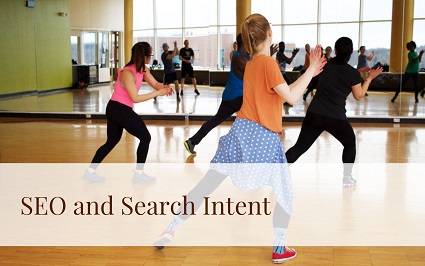Your cart is currently empty!

SEO and Search Intent
One of the most important factors to consider in your SEO strategy is your ideal customer’s path to purchase. If you’re offering a Zumba dance program that helps with joint pain, you need to think about everything your ideal customer does between beginning to feel concerned about joint pain and choosing to sign up with you. Among those actions, there will be (Google tells us) roughly 10 internet searches. You need to be aware of the keywords people use to search. But you also need to be aware of the ways they signal their search intent.
For example, Google treats queries differently based on whether the searcher seems to be looking for a local place or general information.
“Zumba near me” sounds like you want to drop in on a Zumba class. Google will pinpoint your location and serve up some local spots.
“History of Zumba” is more of a casual interest. You want to know something about Zumba, maybe to settle a bet, but you don’t actually have your dance sneakers on. (Don’t worry — NPR has your answer.)
Local search is the easiest example of search intent, but Google takes the concept further.
Beyond local search
For our example, somebody looking for “Zumba near me” may be welcome in your class. They’re ready to buy and you’re happy to help them. They’re close to your studio and they might choose you. They may have walked right out of their osteopath’s office with a note saying, “Find a Zumba class.” Their path to purchase is short and you’re both in luck.
But someone looking specifically for Zumba classes tailored to people with joint pain will probably have a path to purchase that looks something like this:
- Informational searches about joint pain. Are you going to show up? Not if your articles are all optimized for “Zumba.” Your article on exercise and joint pain might show up.
- Informational searches about exercise and joint pain. Your articles recommending Zumba for joint pain may stand out in all those articles about walking and swimming.
- Informational searches about Zumba, once they’re aware of this as an option. This searcher may check out videos, lifestyle blogs, and other information about Zumba that is not associated with joint pain. Do you have this information on your website?
- Commercial investigation searches. Once searchers are intrigued by the idea of taking up Zumba for their joint pain, they’re likely to explore specifics. How much does Zumba cost, is it offered in their neighborhood, should they look for a physical therapist or a dance studio? Their searches are still informational, but they’re likely to include signs of intent to buy: words relating to cost, location, and amenities that don’t show up when people are just curious about Zumba.
- Transactional searches. At this point, after five to ten searches visiting multiple websites, the searcher is ready to find “Zumba close by.”
- Navigational searches. Having identified one or more options, the searcher may intentionally look for one of those places — such as your dance studio.
Where do you want to show up?
If your website is doing its job, searchers should have seen information from your studio in the search engine results several times before they get around to serious shopping. Ideally, you’ve shown up in the search results at every point along their path to purchase.
When they see that your studio is near them, they already know that you have classes for people with joint pain. You’ve already helped them and shared information. When they see “Therapeutic Zumba” on your class list, they’ll be ready.
Search intent and keywords
As you analyze your ideal customer’s path to purchase, consider all the keywords you should be using in your content cluster. You should include essential keywords like “Zumba” and “joint pain,” to continue with our example, but you should also have the terms that show different kinds of search intent.
- exercise and joint pain
- Zumba for joint pain
- Zumba for arthritis
- therapeutic Zumba
- Zumba in [location]
- Zumba class schedule
- your first Zumba class
- Zumba class pricing
A content cluster like this will catch your ideal customer at multiple points along the path to purchase.
by
Tags:


Leave a Reply